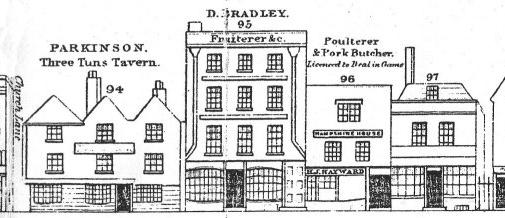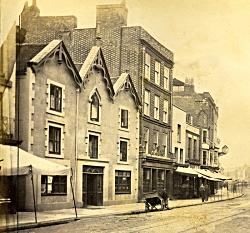
Nos. 94 - 97 High Street

The four buildings in this section are being examined jointly as they lie between the only two means of access to St. Thomas's Church from the High Street. On the left of No. 94 is Church Lane which though very narrow is wider than the alley way to the right of No. 97.
In 1891 Nos. 94 and 95 High Street were purchased by Aldermen Joseph Whitcombe and Thomas King and demolished in order to provide greater access to St Thomas's Parish Church, thereby allowing the church to be fully visible from High Street for the first time in several hundred years. The church had originally been established in the time of John de Gisors who had donated the land, which extended to the edge of High Street, to the Canons of Southwick. Somehow though, by the time of Henry VIII, a row of houses had spread across the space in front of the church. Lilley and Everitt in "Portsmouth Parish Church", published in 1926, attribute this encroachment in part to the mayor John Holloway who is known to have rebuilt two houses there in 1561.
The demolition brought to an end the existence of a building (No. 94) steeped in the history of the town. In it's final years the building had been the Guildhall Tavern and before that (in 1861) the United Services Hotel, but it was perhaps best known as the Three Tuns (as in the 1842 Charpentier drawing). William Gates, in his 'Records of the Corporation' recalls the legend that it was at the Three Tuns that the leaders of the Spithead Mutiny gathered to discuss the terms for settlement whilst keeping Lord Howe and his fellow officers on the stairs awaiting the outcome. There is some doubt though about the veracity of this claim as although Lilley and Everitt repeat the tale, Professor A. Temple Patterson does not mention the incident in his comprehensive history of the mutiny in the Portsmouth Paper No. 4.

Whatever the truth may be, the Three Tuns would have played a prominent role in the travelling lives of stage coachmen and turnkeys transporting prisoners to the hulks in the harbour (according to Gates) as it was one of the oldest buildings on High Street. We are fortunate to have a particularly fine photograph of it taken in the 1880s which for the model purposes is enhanced by also containing images of the adjoining buildings (see left). The image also shows the narrowness of the former access to the church known as Church Lane to the left of the Three Tuns.
Little is known of the three buildings to the right of the inn though we can tell that by comparison to the Charpentier drawing they had altered little in the previous forty years. The most notable features of No. 95 are the chequered brickwork and the prominent drainpipes on the facade, the latter being the sole occurence so far seen on a High Street that preferred to hide such mundane necessities. The other two buildings in this block survived much longer, still being in existence some years after the end of WW2 as can be seen from the photograph (below, right), taken in the 1950s.

From the 1861 OS map we can determine the widths of Nos 94-97 to be 40'0", 24'0", 15'6" and 17'3" respectively. The depths vary from 55' to 40' left to right in a straight line which would have been coincident with the churchyard wall. Looking at the available space in front of the Cathedral today it seems almost incredible that buildings of such depth could have existed on the site. The varying heights of the buildings are inevitably more difficult to ascertain. By comparison to No. 93 the height of the central gable of the United Services Hotel should be around 34', whereas by calculation from the photograph above it is closer to 39'. By counting the brick courses (at 3ft. for 10 courses) on No. 95 we get a height for that building of 48' and a corresponding height for No. 94 of around 36'. Again, by comparison, Nos 96 and 97 are deemed to be 32' and 28' respectively.
By measurement from the available photos the three gables of No. 94 appear to be of equal width, whilst the apex of each outer gable is about 3ft lower than that of the centre gable. Proportionately, all the windows are 5'3" high with the first and second floor windows having widths of 3'6" whilst those on the ground floor are 8'0" wide, the same width as the door. All the windows have a decorated surround, the top central one being difficult to interpret accurately. The gable ends are decorated in a rather cumbersome fretwork structure and although Charpentier does not show this feature other drawings from the mid 19C do (see bottom right).
Although there is no evidence for the roof to No. 95 the photo does show the chimney stack(s) which is fairly rare. The decorative brickwork on the chimney stops at the parapet suggesting that the top of the stack had been rebuilt. There is however only one chimney pot in evidence which presumably means that most of the fires were no longer used. There seems to be a second stack towards the rear of the house but the precise configuration is not clear.
The second and third floor windows are set in brickwork that overhangs the floors below by a few inches, but this brickwork terminates before it reaches the edges of the building which are quite vertical.

The image on the left shows Nos. 96 and 97 High Street as they appeared shortly after the end of World War 2. The photograph is taken from the midst of the ruins of the Guildhall opposite. Both buildings display the same essential properties as in all the images shown above and as such allows us to take proportional dimensions for the windows. On No. 96, the first and second floor windows are 3'6" wide and around 5'9" high, whilst on the first floor of No. 97 they are slightly larger at 4'0" wide and 6'6" in height. The brickwork on No. 97 appears to have been constructed to the same pattern as that on No. 95 suggesting that they were constructed by the same person. If No. 96 had not been rendered we might have seen the same brickwork carry through all three buildings. This photograph gives us very good evidence for the probable roof design in the 1860s and may well be the only image to do so.
The ground floor to No. 96 does not seem to bear much resemblance to that seen darkly in the 1880s photograph and the same can be said of No. 97 which seems to have been converted into a private residence in the intervening years.
Documentary Evidence
Post Office Directory (1859) - Mrs. Ellen Smith, United Services Hotel, High Street; Joseph Barnett, tobacconist, 95 High Street; Stephen Burrows, fruiterer, 96 High Street; Robert Burrows, tobacconist, 97 High Street.
Kelly's (1859) Directory - Eliza Smith, United Services Hotel, 94 High Street; Joseph Barnett, tobacconist, 95 High Street; Stephen Burrows, fruiterer, 96 High Street; Robert Burrows, tobacconist, 97 High Street.
Simpson's (1863) Directory - McLean Rob., United Services Hotel, 94 High Street; Joseph Barnett, cigar merchant, 95 High Street; Alfred Herman Bernthal, tailor and draper, 96 High Street; Robert Burrows, cigar merchant, 97 High Street.
Harrod's (1865) Directory - McLean Roberts & Co. wine and spirits merchants, High Street; Joseph Barnett, importer of foreign cigars, snuff and tobacco, and proprietor of American Bowling Alleys and billiard rooms, 95 High Street; Alfred Herman Bernthal, tailor and draper, 96 High Street; Robert Burrows, tobacconist, 97 High Street.
The 1861 Census records:-
Schedule 83 - Hannah Kegworth (21, Housekeeper), Jane Downey (66, Cook), Henrietta Parkinson (18, Barmaid), Annie Coles (22), William J. Marshall (21, Servant).
Schedule 84 - Joseph Barnett (31, unmarried, Cigar Importer), Mary Ann Gulliver (29, housekeeper), John Frankeiss (18, Shopman), Joseph Sayers (16, Errand Boy), Louisa Lambourn (18, House Servant).
Schedule 85 - Mary Jones (59, Widow, Greengrocer), Annie Hardman (11, Boarder), Henry Jones (5).
Schedule 86 - Robert Burrows (33, Tobacconist), his wife Emma (35), their son Robert (8), cousin Amelia Parkinson (21, Governess) and Selina Ford (12, House Servant).
It is a pity that the head of household at the United Services Hotel appears not to have been at home on the night of the census as this may have helped to clarify whether Eliza (or Ellen) Smith was still landlady or if it had been transferred to McLean Roberts and Co. It is also odd that there are no guests staying at the hotel; perhaps the census caught the very moment the tenancy was being transferred.
The entry for Joseph Barnett in the Harrods directory makes for interesting reading as it seems unlikely that a bowling alley could have been fitted into No. 95, it being less than 50 foot from front to back, including outbuildings. It is always possible that the bowling alleys were in fact at another address. Then alternatively, the building seems far too large (four floors) for one man and four servants, perhaps the bowling alley was on the first floor.
No. 96 seems to have passed through three tenants in the period 1859 to 1865, Stephen Burrows, Mary Jones and Alfred Bernthal, but as Burrows was recorded by Hunt's 1852 Directory as living at 39 High Street he may simply have owned the business at 96 without actually living there. In contrast the neighbouring house was occupied by Robert Burrows throughout that period. We may speculate that Stephen and Robert Burrows were related in some way.
It is noted that the name of Parkinson appears twice in the census and that Charpentier recorded the same name at the Three Tuns Tavern in 1842. Thomas Parkinson also appears as landlord of the United Services Hotel as late as 1852, according to Hunt's Directory. The FreeBMD website records the death of a Thomas Parkinson in June 1857. Perhaps his daughter Henrietta was a barmaid at the time the tenancy changed but stayed on anyway.

Summary
All four buildings retained the same basic structure between 1842 and 1880 though each was modified at ground floor level during that period. The photograph from around 1880 offers an impression that the ground floors shown were not recent modifications which would be in line with the general notion so far in this project that most shop fronts that were renovated during this period were upgraded by the early 1860s. The model will therefore generally follow the structures as they appeared in 1880.
The notion that St Thomas's Church could not have been seen from the High Street prior to the demolition of Nos. 94 and 95 is not entirely accurate, that is if the drawing on the right is to be believed. The problem with this drawing is that the artist could not possibly have portrayed a realistic scene since he would have had to be sited in the middle of the houses opposite to get this perspective. We will have to wait until the church is modelled and placed in it's correct geographical location before the position of the artist can be accurately demonstrated.
The facade to No. 95 is rather difficult to interpret. The fact that the overhang to the second and third floors is not carried through to the corner edges of the building is slightly confusing. Perhaps the unusual drainpipes have been placed to deliberately disguise the edge of the projecting brickwork. The model will demonstrate this feature. The forward chimney to No. 95 will be portrayed as it would have been before it was rebuilt on the assumption that the reconstruction happened after 1860. The rear chimney will not be modelled as it doesn't exist on the drawing (above, right).